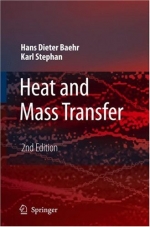Tab Article
This book provides a solid foundation in the principles of heat and mass transfer and shows how to solve problems by applying modern methods. The basic theory is developed systematically, exploring in detail the solution methods to all important problems. The revised second edition incorporates state-of-the-art findings on heat and mass transfer correlations. The book will be useful not only to upper- and graduate-level students, but also to practicing scientists and engineers. Many worked-out examples and numerous exercises with their solutions will facilitate learning and understanding, and an appendix includes data on key properties of important substances.


